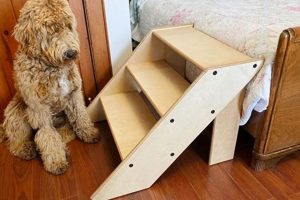Constructing a canine restraint from durable nylon cord offers a customized approach to pet ownership. This practice involves braiding or weaving a strong, resilient lead using multiple strands of the material, providing a secure connection between the handler and the animal. A typical example involves selecting a specific length of cord, choosing a knotting pattern, and securing the ends with hardware to create a functional and visually appealing tether.
The practice presents multiple advantages, including cost-effectiveness and the ability to tailor the length, color, and features to specific needs and aesthetic preferences. The robust nature of the materials involved ensures longevity and reliability, particularly for active dogs. Historically, similar techniques have been employed for creating utilitarian objects, demonstrating the versatility of knotting and weaving in various applications. The ability to repurpose and customize such items speaks to a desire for personalization and resourcefulness.
The subsequent sections will detail the necessary materials, provide step-by-step instructions for various construction techniques, and offer guidance on selecting appropriate hardware to ensure the safety and effectiveness of the finished product. Furthermore, potential customization options and safety considerations will be addressed to provide a comprehensive guide to this crafting endeavor.
Construction Considerations for Durable Canine Restraints
The following guidelines provide essential insights for fabricating a dependable and safe canine restraint, utilizing durable nylon cording.
Tip 1: Cord Selection: Opt for high-quality, continuous filament nylon cord specifically designed for load-bearing applications. Verify tensile strength ratings to ensure suitability for the dog’s size and temperament. A minimum tensile strength of 550 pounds is generally recommended for medium to large breeds.
Tip 2: Knot Integrity: Employ secure and reliable knotting techniques, such as the cobra weave or king cobra weave, to maximize the restraint’s structural integrity. Consistent tension during knotting is critical to prevent loosening or slippage under stress. Regularly inspect knots for wear or fraying.
Tip 3: Hardware Selection: Choose heavy-duty, corrosion-resistant hardware, including swivel snaps and D-rings, constructed from stainless steel or brass. Ensure the hardware’s load rating matches or exceeds the cord’s tensile strength. Inspect hardware regularly for signs of damage or weakening.
Tip 4: Handle Construction: Incorporate a comfortable and ergonomic handle design to minimize strain on the handler’s hand and wrist. Consider incorporating padding or a wider grip area for improved comfort during extended use. Secure the handle to the main body of the restraint using multiple secure knots or stitching.
Tip 5: Length Considerations: Determine the appropriate length based on the intended use. A standard length of four to six feet is generally suitable for walking, while shorter lengths may be preferable for training or close control. Precise length determination is essential for optimal handling and safety.
Tip 6: Safety Inspection: Prior to each use, meticulously inspect the entire assembly for any signs of wear, fraying, or damage to the cord, knots, or hardware. Replace any components exhibiting signs of deterioration to prevent potential failure during use.
Tip 7: Reinforcement Techniques: Implement reinforcement techniques, such as back splicing or constricting knots, at stress points, including the connection between the cord and the hardware. These measures enhance the restraint’s overall durability and prevent premature failure.
Adherence to these construction considerations ensures the creation of a dependable and safe canine restraint, maximizing both the dog’s security and the handler’s control.
The following section will focus on the creative aspect of canine restraint design, highlighting various personalization options.
1. Strength
The inherent strength of materials and construction techniques directly dictates the suitability and safety of a canine restraint fashioned from nylon cord. Adequate tensile strength is paramount to prevent breakage under the strain of a pulling dog, ensuring secure control and mitigating potential hazards in various environments.
- Cord Material Tensile Rating
The load-bearing capacity of the nylon cord is a fundamental determinant of overall strength. Specific types of nylon cord possess varying tensile strengths, typically measured in pounds. Selection of a cord with a sufficient rating, exceeding the anticipated force exerted by the dog, is critical. Failure to account for this parameter can lead to catastrophic failure of the leash under stress.
- Knot Security and Integrity
The knots employed in the construction significantly influence the leash’s ability to withstand pulling forces. Improperly tied or weak knots can unravel or slip under tension, compromising the integrity of the entire structure. Employing established knotting techniques designed for load-bearing applications, such as the cobra weave or diamond knot, is essential for maximizing strength.
- Hardware Load Capacity
The hardware components, including swivel snaps and D-rings, must possess adequate load capacity to match or exceed the tensile strength of the cord. Inferior hardware is prone to deformation, breakage, or detachment under stress, negating the strength of the cord itself. The use of high-quality, corrosion-resistant materials, such as stainless steel, ensures both strength and longevity.
- Construction Technique Consistency
Maintaining consistent tension and uniformity throughout the weaving or braiding process is vital to achieving optimal strength. Inconsistent tension can create weak points within the structure, rendering it susceptible to failure under stress. A meticulous and deliberate approach to construction is necessary to ensure even distribution of load and maximize overall strength.
In summary, the strength of a canine restraint crafted from nylon cord is not solely dependent on the cord material itself, but rather a confluence of factors including cord tensile rating, knot security, hardware load capacity, and consistent construction techniques. Each element contributes to the overall performance and safety of the leash, highlighting the importance of careful consideration and execution during the fabrication process.
2. Durability
Durability is a paramount consideration in the fabrication of canine restraints utilizing nylon cord. The capacity of a leash to withstand repeated use, exposure to environmental factors, and the dynamic forces exerted by a dog directly influences its safety and longevity. A durable leash minimizes the risk of failure and provides long-term value.
- Material Resistance to Abrasion
Nylon cord is inherently resistant to abrasion, a critical characteristic given the potential for friction against various surfaces, including pavement, vegetation, and the dog’s own body. The continuous filaments within the cord resist fraying and degradation, maintaining structural integrity over extended periods. The selection of a cord specifically designed for outdoor use further enhances its resistance to abrasive wear, ensuring a longer lifespan.
- UV Resistance and Colorfastness
Exposure to ultraviolet (UV) radiation can degrade the structural integrity of certain materials and cause fading of colors. High-quality nylon cord exhibits resistance to UV degradation, preventing premature weakening and maintaining the leash’s aesthetic appeal over time. Colorfastness ensures that the color remains vibrant despite prolonged exposure to sunlight, preserving the leash’s visibility and overall appearance.
- Resistance to Moisture and Rot
Canine restraints are frequently exposed to moisture through rain, dew, or immersion in water. Nylon cord is naturally hydrophobic, resisting water absorption and preventing the growth of mold or mildew. This resistance to moisture and rot ensures that the leash remains strong and functional even after repeated exposure to wet conditions, contributing to its long-term durability.
- Hardware Corrosion Resistance
The hardware components, such as swivel snaps and D-rings, are susceptible to corrosion, particularly in humid or coastal environments. The selection of corrosion-resistant materials, such as stainless steel or brass, is essential for maintaining the hardware’s integrity and functionality over time. Regular inspection and maintenance of the hardware further prolong its lifespan and ensure its continued contribution to the leash’s overall durability.
These facets of durability, encompassing material resistance to abrasion, UV resistance, moisture resistance, and hardware corrosion resistance, collectively determine the lifespan and reliability of a canine restraint fashioned from nylon cord. Prioritizing these considerations during construction ensures a product that withstands the rigors of daily use, providing a safe and long-lasting connection between the handler and the animal.
3. Customization
The application of customization to canine restraints constructed from nylon cord stems from a confluence of practical needs and aesthetic desires. The practice allows for precise tailoring of leash length to suit specific training regimens or walking environments. For example, a shorter leash may be preferred for close-quarters obedience work, whereas a longer lead offers greater freedom in open spaces. Further, customization extends to color selection, enabling owners to coordinate with canine accessories or personal preferences. This personalized approach enhances both functionality and visual appeal.
The ability to adjust the handle configuration represents another significant facet of customization. Padding can be incorporated to mitigate discomfort during extended use, particularly with larger or more energetic dogs. Moreover, the incorporation of additional hardware, such as D-rings for attaching waste bags or training clickers, addresses practical requirements. Real-world examples of this include leashes designed with integrated traffic handles for enhanced control in crowded areas, or leashes with adjustable lengths, accommodating varying levels of canine freedom.
In summary, customization within the context of crafting canine restraints from nylon cord provides a tangible means of addressing individual needs and preferences. It transcends mere aesthetics, impacting functionality, ergonomics, and the overall user experience. The ability to tailor the leash to specific purposes and canine characteristics underscores the value of this design approach, fostering a more effective and enjoyable interaction between owner and animal.
4. Knotting Technique
The selection and execution of knotting techniques constitute a critical factor in determining the strength, durability, and overall utility of a canine restraint constructed from nylon cord. The integrity of the knots directly impacts the leash’s capacity to withstand tensile forces and resist wear, thereby influencing its safety and longevity.
- Knot Selection Criteria
The choice of knotting technique should be predicated upon several criteria, including knot strength, security, ease of tying, and aesthetic considerations. Knots commonly employed in load-bearing applications, such as the cobra weave, king cobra weave, and diamond knot, offer a high degree of security and resistance to slippage. The selection process should also consider the complexity of the knot, balancing strength requirements with the practical limitations of the crafting process. For instance, a complex knot may offer superior strength but prove impractical for novice crafters. The implications of selecting an inappropriate knotting technique range from premature leash failure to potential injury of the handler or the dog.
- Knotting Procedure Precision
The manner in which a knot is tied directly affects its strength and security. Improperly executed knots can unravel under tension or create stress concentrations that lead to premature failure. Maintaining consistent tension throughout the knotting process is crucial for ensuring uniform load distribution and preventing weak points within the structure. Furthermore, the finishing of the knot, including the securing of loose ends, contributes to its overall integrity. Examples of imprecise knotting include inconsistent weave tension resulting in a lopsided or weakened leash, or improperly secured ends that fray and unravel over time.
- Knot Inspection and Maintenance
Regular inspection of the knots is essential for identifying signs of wear, fraying, or slippage. Early detection of these issues allows for timely repair or replacement, preventing catastrophic failure during use. Maintenance procedures may include tightening loose knots, trimming frayed ends, and applying a protective sealant to prevent further degradation. Neglecting knot inspection and maintenance can lead to a gradual weakening of the leash, increasing the risk of breakage or accidental release. In a practical example, a small amount of fraying on a knot left unattended can quickly lead to the complete failure of the weave.
- Adaptation for Hardware Integration
Knotting techniques must be adapted to seamlessly integrate hardware components, such as swivel snaps and D-rings, into the leash structure. Securely attaching the hardware requires specialized knots or splicing techniques that prevent the hardware from detaching under load. The method used for integrating hardware should distribute the load evenly across the cord, minimizing stress concentrations. For instance, a poorly executed connection between the cord and a swivel snap can result in the snap detaching under even moderate strain, rendering the leash useless. Conversely, properly secured hardware ensures a strong and reliable connection between the leash and the dog’s collar or harness.
In summation, the knotting technique employed in the construction of a canine restraint from nylon cord transcends mere aesthetics; it is a critical determinant of structural integrity and overall safety. Careful consideration of knot selection criteria, precise execution of the knotting procedure, diligent inspection and maintenance, and thoughtful adaptation for hardware integration are all essential for producing a durable and reliable leash.
5. Hardware Quality
The integrity of a canine restraint fashioned from nylon cord hinges significantly upon the quality of its constituent hardware. The swivel snap, D-ring, and any other metallic components directly bear the forces exerted by the animal. Substandard hardware, regardless of the cord’s tensile strength or the proficiency of knotting techniques, represents a critical point of potential failure. A fractured snap link, a bent D-ring, or a corroded clasp can instantaneously compromise the leash, potentially leading to a dog escaping control and facing associated hazards. The selection of appropriate hardware, therefore, is not merely an aesthetic consideration, but a fundamental element of safety.
The application of appropriate hardware materials and construction directly corresponds to the functionality and longevity of the leash. Stainless steel and brass, renowned for their corrosion resistance, are preferred over plated steel that may succumb to rust and degradation in humid or marine environments. Load ratings imprinted on hardware provide essential information regarding their capacity to withstand specific forces. Exceeding these load ratings, even marginally, compromises the structural integrity and significantly increases the risk of failure. For instance, employing a snap hook designed for lightweight applications on a leash intended for a large breed represents a critical safety oversight. An illustrative example demonstrates the importance of hardware is a D-ring breaking while a dog is pulling, it led to an accident that could have been avoided with the proper hardware.
In summation, hardware quality is an indispensable component of a reliable canine restraint constructed from nylon cord. Neglecting this aspect, irrespective of the quality of the nylon cord or knotting skill, can yield a product that is functionally inadequate and presents a tangible safety risk. Therefore, careful attention must be given to material selection, load ratings, and construction quality to ensure that the hardware performs as expected and contributes to the overall dependability of the leash. The investment in high-quality hardware is a prudent measure that safeguards both the animal and the handler.
6. Ergonomics
Ergonomics plays a crucial role in the design and creation of canine restraints using nylon cord. The principles of ergonomics seek to optimize human well-being and overall system performance by adapting products and environments to the capabilities and limitations of the user. Applying ergonomic considerations to the fabrication of canine restraints enhances both user comfort and control, thereby contributing to a safer and more enjoyable experience for both the handler and the animal.
- Handle Design and Grip
The design of the leash handle directly impacts user comfort and reduces the risk of strain or injury. A handle that is too narrow or lacks adequate padding can cause discomfort and fatigue, particularly during extended use or with a dog that pulls forcefully. Conversely, a handle that is too large or unwieldy can impair dexterity and control. Ergonomic handle designs often incorporate contoured shapes, padded grips, and strategically placed finger grooves to promote a natural and comfortable hand position. Real-world examples include handles constructed with neoprene padding or those featuring a wider grip area to distribute pressure more evenly across the hand. The implications of poor handle design range from minor discomfort to more serious conditions such as carpal tunnel syndrome.
- Weight Distribution and Balance
The overall weight and balance of the leash can significantly affect user fatigue and control. A leash that is too heavy or poorly balanced can strain the wrist and forearm, particularly during prolonged use. Distributing the weight evenly across the leash’s length minimizes the risk of imbalance and improves handling. The choice of materials and the complexity of the knotting pattern influence the weight of the finished product. For instance, a leash constructed with multiple layers of nylon cord or incorporating heavy hardware will naturally be heavier than a simpler design. Maintaining a balanced weight distribution, where the weight is evenly distributed along the leash, optimizes handling and reduces the strain on the user’s hand and wrist. An unbalanced leash may result in the user being easily pulled off balance or experiencing discomfort.
- Length and Reach Considerations
The length of the leash directly affects the handler’s reach and control over the dog. A leash that is too short can restrict the dog’s movement and limit its ability to explore, while a leash that is too long can make it difficult to maintain control, especially in crowded or hazardous environments. The ideal leash length should allow the dog sufficient freedom of movement while enabling the handler to maintain a secure grip and effectively manage the dog’s behavior. Considerations regarding leash length also extend to variations with specific needs. For example, leashes with built-in extensions allow the owner to adjust the leash length to control the level of movement for a particular dog. Leash extenders may also include a cushioned area to allow for comfort while holding onto the leash. Ultimately, appropriate leash length fosters a balance between canine freedom and handler control.
- Hardware Placement and Operation
The placement and ease of operation of the leash hardware, such as the swivel snap, affect the user’s ability to quickly and efficiently attach and detach the leash. A swivel snap that is difficult to open or close can be frustrating and time-consuming, particularly in situations where quick action is required. Similarly, a swivel snap that is poorly positioned can be awkward to operate and increase the risk of accidental release. Ergonomic hardware designs prioritize ease of use and secure attachment. Examples include swivel snaps with a large, easy-to-grip lever or those featuring a smooth, frictionless swivel action. Careful consideration of hardware placement and operation ensures that the leash is easy to use and reduces the risk of accidents.
In summary, the integration of ergonomic principles into the design and construction of canine restraints using nylon cord is essential for promoting user comfort, enhancing control, and ensuring safety. Careful consideration of handle design, weight distribution, length, and hardware placement contributes to a product that is not only functional and durable but also comfortable and easy to use.
7. Safety Inspection
Diligent safety inspection represents a cornerstone in the responsible utilization of a canine restraint constructed from nylon cord. The handcrafted nature of such a leash necessitates regular and thorough evaluation to ensure its continued structural integrity and to mitigate potential risks associated with wear, tear, or component failure.
- Cord Integrity Assessment
Regular assessment of the nylon cord’s condition is crucial. This involves visually and tactilely inspecting the cord for signs of fraying, abrasion, or discoloration, which may indicate weakening of the material. Real-world scenarios often expose the cord to abrasive surfaces such as pavement or vegetation, accelerating wear. Ignoring these signs can lead to sudden breakage during use, potentially resulting in the loss of control over the dog and associated safety hazards.
- Knot Security Verification
The knots securing the leash’s structure must be routinely examined for tightness and stability. Loosening or slippage of knots compromises the overall strength of the leash and can lead to unraveling. A simple tug test on each knot can reveal subtle signs of instability. An example is an unsecured or improperly tightened cobra weave can lead to full separation of the cord from the handle.
- Hardware Functionality Evaluation
Hardware components, including swivel snaps and D-rings, warrant careful evaluation for proper functionality. The swivel snap should operate smoothly without sticking or binding, and the D-rings should exhibit no signs of bending or distortion. Corrosion or rust on metal parts indicates a weakening of the material and an increased risk of failure. For instance, a corroded swivel snap may unexpectedly break, releasing the dog from the leash. Regular lubrication with appropriate products can prolong the lifespan of these components.
- Stress Point Examination
Particular attention should be paid to areas of high stress, such as the points where the cord connects to the hardware or where the handle attaches to the main leash body. These areas are subject to increased strain and are more prone to wear or damage. Reinforcement techniques, such as back splicing or constricting knots, can mitigate stress at these points, but regular inspection remains essential. An example is when the connection point between the cord and the swivel snap is not reinforced, the cord will eventually fray and break.
The facets of a safety inspection are critically relevant in the context of crafting a canine restraint from nylon cord. Unlike mass-produced leashes that undergo standardized quality control procedures, these handcrafted items rely entirely on the diligence and expertise of the creator for ensuring safety and reliability. Neglecting regular and thorough inspections undermines the intended purpose of the leash and exposes both the dog and the handler to unnecessary risks. Consistent examination and maintenance are therefore paramount to safe utilization.
Frequently Asked Questions
The following questions address common concerns regarding the construction and utilization of canine restraints crafted from nylon cord.
Question 1: What minimum tensile strength is recommended for nylon cord used in leash construction?
A minimum tensile strength of 550 pounds is generally recommended for medium to large breed dogs. Smaller breeds may necessitate a lower rating, but erring on the side of caution is advised. The cord should be specifically designated for load-bearing applications.
Question 2: How frequently should a nylon cord leash be inspected for wear and tear?
A thorough inspection should occur prior to each use. The nylon cord, knots, and hardware should be scrutinized for any signs of fraying, abrasion, corrosion, or deformation.
Question 3: What are the most secure knotting techniques for constructing a dog leash?
The cobra weave and king cobra weave are commonly employed due to their inherent strength and resistance to slippage. However, proper execution and consistent tension during the knotting process are paramount for ensuring knot security.
Question 4: Is it necessary to use specialized hardware for a homemade leash?
The utilization of high-quality, load-rated hardware is non-negotiable. Stainless steel or brass swivel snaps and D-rings are recommended due to their corrosion resistance and durability. Hardware load ratings should meet or exceed the tensile strength of the nylon cord.
Question 5: Can a homemade nylon cord leash be safely used for a dog that pulls excessively?
While nylon cord is inherently strong, a dog that consistently pulls exerts significant stress on the leash and hardware. Reinforcing stress points and utilizing heavy-duty hardware is crucial. In extreme cases, a commercially manufactured leash designed for strong pullers may be a more prudent option.
Question 6: How does exposure to environmental factors affect the lifespan of a nylon cord leash?
Prolonged exposure to ultraviolet (UV) radiation, moisture, and abrasive surfaces can degrade the nylon cord and hardware. Storing the leash in a dry, shaded area when not in use minimizes environmental damage. Regular cleaning and inspection are essential for prolonging its lifespan.
These inquiries underscore the importance of meticulous construction and diligent maintenance in ensuring the safety and efficacy of a canine restraint fabricated from nylon cord. Adherence to these guidelines promotes both animal and handler well-being.
The subsequent section will address legal and ethical considerations pertaining to leash usage and responsible pet ownership.
Conclusion
This exploration of the diy paracord dog leash has illuminated critical factors pertaining to its construction, safety, and utility. From selecting materials with appropriate tensile strength and resistance to environmental degradation, to employing secure knotting techniques and robust hardware, each aspect demands meticulous attention. Regular safety inspections are indispensable for identifying and mitigating potential risks associated with wear and tear.
The decision to construct a diy paracord dog leash necessitates a commitment to responsible craftsmanship and ongoing evaluation. The structural integrity of this device is directly linked to the well-being of both the animal and its handler. Therefore, prioritize safety, adhere to best practices, and remain vigilant in monitoring the leash’s condition to ensure a secure and controlled connection.







